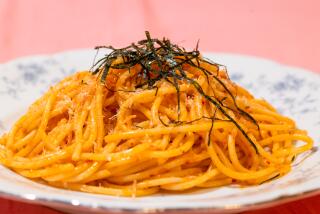The Wilder Shores of Ham
What do you serve at Easter dinner? If your roots are in the Mediterranean, probably lamb. Apart from lamb’s religious associations, it’s a natural for a springtime feast because it’s always available at that time of year.
If you have New England ancestors, you may repeat the Thanksgiving turkey; but if your ancestors came from northern Europe, the meat is probably ham. Seasonality has everything to do with it. No matter what (if anything) might be available fresh at Eastertide, a farmer could always save a ham for breaking the Lenten fast.
These days, we don’t have to plan ahead to serve ham at Easter. All we have to do is pick out a ham at the market. And unlike the hams of yesteryear, which needed a day or more of soaking before they could be boiled (and baked only after that), most of today’s hams are ready to cook--or even precooked and ready to eat.
Supermarket hams are not only convenient but mild-tasting and easy to like. The ways you know of serving a ham probably presume this sort of meat, and using another kind means not only planning and more work but possibly quite a different way of serving. So no matter what else is out there, most of us will go on using the ham we’re used to.
But we’re the Food section, and we just had to examine the options. We dug up the names of more than a score of mail-order ham sources and tried hams from almost half of them. According to an old saying, eternity is two people and a ham. We found that one Food section and nine hams seemed plenty long but never dull.
Mail-order hams fall into two categories: old-fashioned country hams, nearly all from the South, and ready-to-cook precooked “city” hams. The mail-order hams promise superior flavor, as well they should: They can cost anything from 60% more than a supermarket ham to four or five times as much.
To give an idea of the variety out there, here are our notes on the hams we tasted.
CITY HAMS
1. Harrington’s cooked, spiral-sliced party ham. Suave corncob smoke flavor, understated maple glaze. Even away from the glaze, the meat tasted sweet. By far the most expensive ham by weight ($59.95 for an 8-pound ham) but irresistible. People couldn’t stop eating it.
2. Ozark Trails hickory bone-in peppered ham. Definitely a city ham--moist and ready to eat, not terribly salty--but with a remarkable degree of the country ham flavor, a heady cured aroma akin to wine or Swiss cheese. This ran a very close second to the Harrington’s ham.
3. Meadow Farms country smokehouse ham. A unique California ham that has been smoked in Bishop since 1922 using a wood known as mountain mahogany. The meat itself is denser and drier than supermarket ham and the smoke flavor is intense and distinctive, not at all like the usual hickory or fruitwood smoke. Some tasters found the aroma strange, but it made the native Californians nostalgic for the campfires of their youth.
4. Burger’s Smokehouse city ham. Made by a Missouri company known for extremely down-home Ozark hams but nowhere near as distinctive; just a good city-style ham.
5. Nueske’s Hillcrest Farm old-fashioned bone-in ham. This ham, from a maker of absolutely wonderful bacon, had a delightful applewood smoke flavor, but only on the outside. There was scarcely any smokiness to the meat when you cut into it. A surprisingly bland ham.
COUNTRY HAMS
1. Edwards country-style hickory smoked Virginia ham. Made just 15 miles up the road from Smithfield, Va. Complex, winey country ham aroma with a blue cheese note.
2. Gatton Farms Father’s country ham. As a result of the publicity that came when this ham ranked first in a recent magazine ham tasting, the producer is out of his top-of-the-line 15-month-old hams. The ham we tasted was only 9 months old and had a pleasant country ham flavor, but not near as rich a flavor as some 15-month ham slices we were able to order. We recommend having some other ham for Easter but getting in an order now for a 15-month ham for Thanksgiving.
3. Burger’s Smokehouse Ozark country ham. Grassy, barnyard-like aroma that some tasters found just too country for them.
Too late to judge: Newsom’s Old Mill Store ham. This 15-month-old ham, smoked with hickory in an iron kettle by a store that has been family-owned since 1917, was the most aggressively old-fashioned-looking ham any of us had ever seen. It’s still soaking in the kitchen; we’ll report on it in Wednesday’s Food section.
PASTA WITH COUNTRY HAM AND SUN-DRIED TOMATOES
1/2 pound dried pasta
2 cups whipping cream
2 ounces sun-dried tomatoes
3 ounces country ham, cut up, about 1/2 cup
Freshly ground black pepper
Adapted from “Hoppin’ John’s Lowcountry Cooking” by John Martin Taylor (Bantam, 1992).
Cook pasta in boiling water according to package directions until just tender.
Meanwhile, put cream in saucepan. Crumble in sun-dried tomatoes and add ham. Bring to low boil and cook, stirring frequently, 5 to 10 minutes. Add dozen or so grinds black pepper per person to sauce, but no salt. Serve sauce on drained pasta.
2 servings. Each serving:
739 calories; 735 mg sodium; 102 mg cholesterol; 28 grams fat; 94 grams carbohydrates; 26 grams protein; 0.36 gram fiber.
JAMBALAYA
2 onions, chopped
4 tablespoons butter
1 (28-ounce) can tomatoes
1/2 (6-ounce) can tomato paste, about 1/4 cup
4 cloves garlic, chopped
1 stalk celery, chopped
1/4 bell pepper, chopped
1 teaspoon minced parsley
1/2 teaspoon thyme
3 cloves
1 pound cooked ham, diced, about 2 1/2 cups
1 pound shrimp, peeled, deveined and boiled
3 cups cooked rice
Salt
Black pepper
Cayenne pepper
This recipe, served at the famous restaurant Corinne Dunbar’s, comes from “The New Orleans Restaurant Cookbook” by Deirdre Stanforth (Doubleday, 1976).
Saute onions in butter 5 minutes. Add tomatoes and tomato paste and cook 5 minutes, stirring constantly. Add garlic, celery, bell pepper, parsley, thyme and cloves and cook 30 minutes, stirring frequently.
Stir in ham and cook 5 minutes. Stir in shrimp and cook 5 minutes. Stir in rice, season to taste with salt, pepper and cayenne and simmer 30 minutes, stirring often.
8 servings. Each serving:
327 calories; 1,079 mg sodium; 118 mg cholesterol; 10 grams fat; 34 grams carbohydrates; 25 grams protein; 1.08 grams fiber.
SHRIMP WITH PEAS AND HAM
1 pound small shrimp
2 tablespoons dry Sherry
1 egg white, lightly beaten
1 tablespoon cornstarch
Vegetable oil
1 cup frozen or fresh peas
1 slice ginger root, minced
1 1/2 teaspoon salt
1/2 cup cooked country ham
2 teaspoons sesame oil
Another version of shrimp with ham comes from “The Key to Chinese Cooking” by Irene Kuo (Alfred A. Knopf, 1977).
Rinse, dry, shell and devein shrimp. Place in bowl with 1 tablespoon Sherry. Add egg white and cornstarch and mix well. Add 1 tablespoon vegetable oil and stir until smooth. Refrigerate at least 1 hour.
Heat 2 cups vegetable oil in skillet to 275 degrees or until cube of bread thrown in oil foams very slowly. Scatter shrimp in oil and stir gently in rocking motion so that they separate and are coated with oil. When they turn white with pinkish undertone, immediately remove from oil with skimmer and drain.
Bring 2 cups water to boil in saucepan and cook frozen peas 40 seconds. (Note: If using fresh peas, cook 3 minutes.) Remove from water and sprinkle with cold water to stop cooking.
Heat wok or large, heavy skillet. Add 2 tablespoons vegetable oil, swirl and heat 30 seconds. Toss in ginger and press in oil. Add peas and stir several times, then sprinkle in 1 tablespoon Sherry and 1/2 teaspoon salt and stir rapidly. Add shrimp and toss lightly. Add 1 teaspoon salt and stir. Scatter in ham, dribble in sesame oil and stir in sweeping motions 30 seconds. Pour into serving dish.
3 to 4 servings. Each of 4 servings:
309 calories; 1,355 mg sodium; 181 mg cholesterol; 16 grams fat; 8 grams carbohydrates; 29 grams protein; 0.77 gram fiber.
More to Read
Eat your way across L.A.
Get our weekly Tasting Notes newsletter for reviews, news and more.
You may occasionally receive promotional content from the Los Angeles Times.










